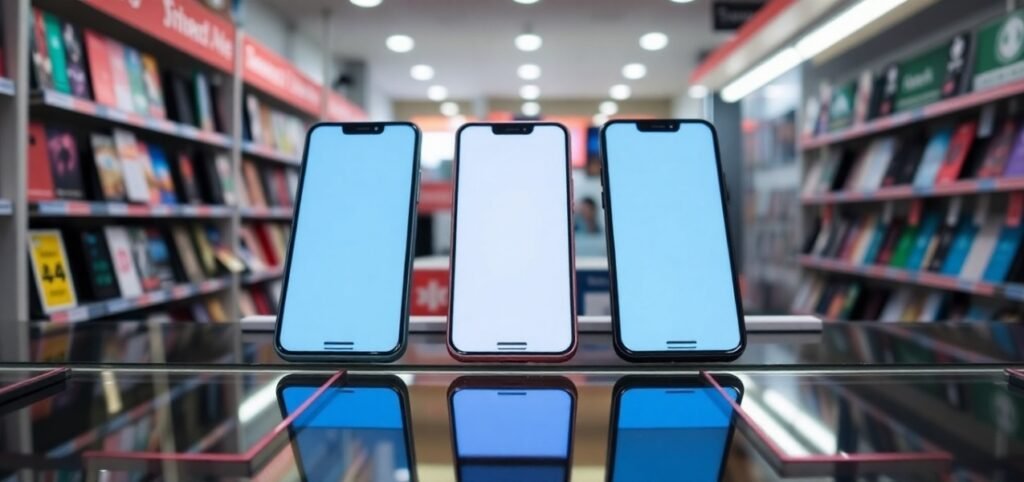Choosing a new phone can be exciting, but understanding the different types of mobile phone screens can be tricky. Screens are the most interactive part of your smartphone, so knowing what suits your needs is essential. In this guide, we’ll explore the most common types of screens, their features, and which one might be right for you.

Types of Mobile Phone Screens
1. LCD (Liquid Crystal Display)
What is LCD?
LCD screens are among the most popular types of mobile phone screens, especially in budget and mid-range devices. They use a backlight to illuminate liquid crystals, which create the display.
Advantages:
- Bright and easy to read in direct sunlight.
- Cost-effective, making them great for budget phones.
Disadvantages:
- Blacks appear grayish due to the backlight.
- Consumes more power compared to other screen types.
LCD screens are great for users who want a reliable display for everyday tasks like texting, browsing, and watching videos.
2. IPS LCD (In-Plane Switching LCD)
What is IPS LCD?
An upgrade to standard LCD, IPS LCD screens offer better color reproduction and wider viewing angles. Many modern smartphones use this technology. (Mobile Phone Screen)
Advantages:
- Superior color accuracy compared to regular LCDs.
- Excellent viewing angles, making it ideal for sharing your screen.
Disadvantages:
- Slightly more expensive than standard LCD.
- Still less efficient than OLED screens.
If you enjoy watching high-quality videos or gaming, an IPS LCD screen could be a great choice for you.
3. OLED (Organic Light Emitting Diodes)
What is OLED?
Unlike LCD screens, OLED displays do not require a backlight. Each pixel produces its own light, offering better contrast and deeper blacks. (Mobile Phone Screen)
Advantages:
- Stunning color accuracy and contrast.
- Energy-efficient, especially when displaying darker content.
- Slimmer design due to no need for a backlight.
Disadvantages:
- Can be more expensive than LCD screens.
- Risk of screen burn-in with prolonged static images.
OLED screens are perfect for those who prioritize vibrant colors and cinematic quality.
4. AMOLED (Active Matrix OLED)
What is AMOLED?
AMOLED screens are an advanced version of OLED technology. They offer faster refresh rates and improved energy efficiency. (Mobile Phone Screen)
Advantages:
- Perfect for high-definition video and gaming.
- Energy-efficient, especially in always-on displays.
- Deeper blacks and more vibrant colors.
Disadvantages:
- Expensive, found mostly in high-end devices.
- Durability can be a concern with prolonged use.
If you’re a tech enthusiast or love premium smartphones, AMOLED screens are a fantastic option.
5. Super AMOLED
What is Super AMOLED?
Super AMOLED is a proprietary technology developed by Samsung. It integrates the touch layer directly into the screen, making it thinner and more responsive.
Advantages:
- Improved visibility in bright sunlight.
- Extremely vibrant and sharp visuals.
- Highly energy-efficient.
Disadvantages:
- Higher price point.
- Susceptible to burn-in over time.
Super AMOLED screens are ideal for those who want the best display technology available, especially in flagship smartphones.
6. Retina Display
What is Retina Display?
A term coined by Apple, Retina Display refers to screens with such high pixel density that the human eye cannot distinguish individual pixels.
Advantages:
- Crisp and detailed visuals.
- Ideal for text-heavy tasks and media consumption.
Disadvantages:
- Exclusive to Apple devices.
- Can be costly compared to standard displays.
If you’re an Apple fan, the Retina Display is designed to provide a seamless and enjoyable viewing experience.
7. Foldable Displays
What are Foldable Displays?
Foldable screens are an innovation, allowing devices to have flexible displays that can fold or expand for multitasking.
Advantages:
- Offers a larger screen area in a compact form.
- Great for multitasking and entertainment.
Disadvantages:
- Expensive and prone to durability issues.
- Limited to high-end smartphones.
Foldable screens are for those who love cutting-edge technology and need a versatile display for work or entertainment.
Conclusion
Now that you know the different types of mobile phone screens, you can make an informed choice when buying your next device. Whether you prioritize color accuracy, battery life, or budget, there’s a screen type for everyone. Remember, the screen is your main interaction point, so choose wisely!
